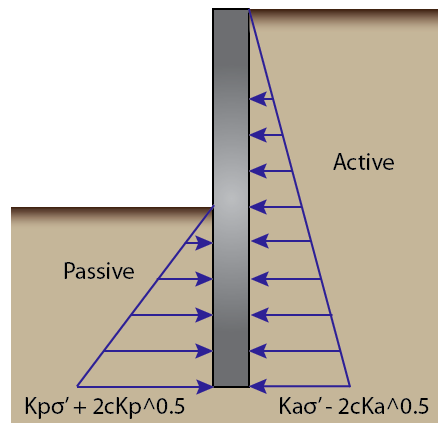Lateral Earth Pressure
Lateral Earth Pressure is the horizontal pressure applied by or to soil when it is against standing structures like basements (buildings) and retaining walls. The lateral earth pressure (\( \sigma_h’ \)) at any depth is a factor (K) of the vertical effective stress (\( \sigma_v’ \)) and cohesion (c):
Active: $$ \sigma_h’ = K_a \sigma_v’ – 2c \sqrt{K_a}$$
Passive: $$ \sigma_h’ = K_a \sigma_v’ + 2c \sqrt{K_p}$$
At Rest: $$ \sigma_h’ = K_o \sigma_v’$$ Click here to continue reading
Material You Can Bring in to the Exam
 As we are nearing an exam weekend I thought it would be good to go over what you can and cannot bring in to the exam. The NCEES is extremely strict about what you have so please, unless you want to be escorted out by the police, follow their guidelines!
As we are nearing an exam weekend I thought it would be good to go over what you can and cannot bring in to the exam. The NCEES is extremely strict about what you have so please, unless you want to be escorted out by the police, follow their guidelines!
NO CELLPHONE, leave it in the car! If your Android IceCream buzzes during the test -> instant police escort.
Average End-Area Method
The Average End-Area method is a useful tool for estimating quantities in construction. It is an approximate method of calculating volume and is accurate enough for most situations.
The general concept is that you calculate the total volume (V) of a material given, the area of two ends (A) and the perpendicular distance between the two area-faces (L). For a volume comprised of several sections you sum them up:
$$ V = \sum{L \frac{A_1+A_2}{2}} $$
Deciphering What to Study for the PE Exam
The reference books won’t help you decide what to study, it would be great if they had little Breadth or Depth indicators in the section headers… but they don’t. So it is upon you to decipher what to study.
Several times now, I have realized far too late that the topic I am studying in the CERM or AIO is not relevant to what I need. In most cases this is due to me stumbling into a section of a chapter that is for the depth test on the topic instead of the breadth.
Just today I was studying the Hydraulic Machines chapter of the CERM (Chapter 18). This section covers pumps and other hydraulic machines and things like efficiency, speeds, horsepower, changes in energy head etc. All of those things will be in the breadth section so it is good I studied them. However after covering speed, the chapter jumps straight into cavitation and suction which only appear on the hydraulic depth section. I will admit those things are interesting but I probably should been studying something that will be relevant to me.
The easiest way to stay on course is to constantly refer to the exam specifications on what to study:


